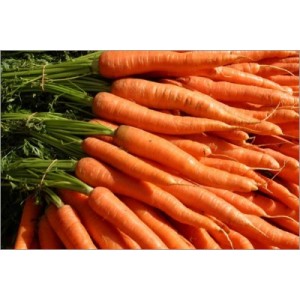The carrot (Daucus carota subsp. sativus, Etymology: Middle French carotte, from Late Latin carōta, from Greek karōton, originally from the Indoeuropean root ker- (horn), due to its horn-like shape) is a root vegetable, usually orange or white, or red-white blend in colour, with a crisp texture when fresh. The edible part of a carrot is a taproot. It is a domesticated form of the wild carrot Daucus carota, native to Europe and southwestern Asia. It has been bred for its greatly enlarged and more palatable, less woody-textured edible taproot, but is still the same species.It is a biennial plant which grows a rosette of leaves in the spring and summer, while building up the stout taproot, which stores large amounts of sugars for the plant to flower in the second year. The flowering stem grows to about 1 metre (3 ft) tall, with an umbel of white flowers that produce a fruit called a mericarp by botanists, which is a type of schizocarp.[1]






















Write your review
* Required fields
or Cancel